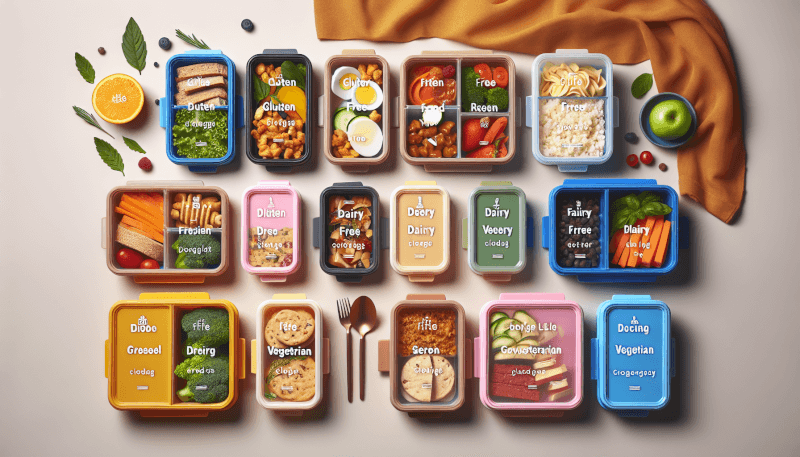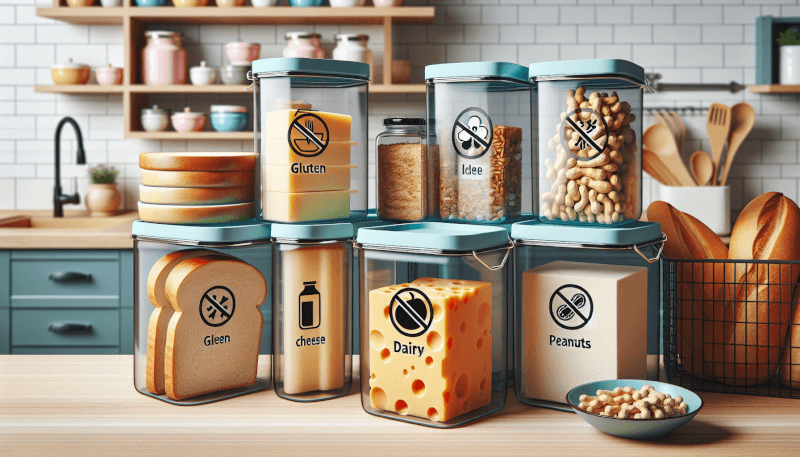In today’s article, you will discover an essential topic that can be a game-changer for individuals with dietary restrictions: food storage. Whether you follow a specific diet due to health reasons or personal choices, it can sometimes feel challenging to find suitable options to store your food safely. However, fret not! We are here to explore the various safeguarding options available, ensuring that your dietary needs are met while keeping your food fresh and secure. So, let’s dive into this informative journey and unlock a world of possibilities for your food storage needs!

1. Understanding Dietary Restrictions
1.1 Allergies
Allergies are immune responses triggered by specific foods. They can range from mild reactions, such as hives or itching, to severe and life-threatening anaphylaxis. Common food allergies include nuts, shellfish, eggs, and dairy products. It is crucial to avoid these allergens completely to prevent any adverse reactions.
1.2 Intolerances
Intolerances occur when your body has difficulty digesting certain foods. Lactose intolerance, for example, is the inability to digest lactose, the sugar found in milk and dairy products. Symptoms may include bloating, gas, and diarrhea. It is important to identify and avoid the specific foods that cause intolerance.
1.3 Medical Conditions
Certain medical conditions, such as diabetes or high blood pressure, require dietary modifications to manage symptoms effectively. For instance, individuals with diabetes need to monitor their carbohydrate intake and control their blood sugar levels. Understanding these conditions and following recommended dietary guidelines is crucial for maintaining overall health.
1.4 Religious or Cultural Restrictions
Religious or cultural beliefs may dictate specific dietary restrictions. For example, some individuals may follow a kosher or halal diet, which has specific guidelines for the preparation and consumption of food. It is essential to respect and accommodate these restrictions to ensure inclusivity and promote cultural diversity.
2. Importance of Proper Food Storage
2.1 Maintaining Freshness and Quality
Proper food storage helps maintain the freshness and quality of ingredients, ensuring that they are safe to consume. Storing foods in optimal conditions, such as the right temperature and humidity, can extend their shelf life and prevent spoilage. By keeping your food fresh, you can enjoy the full flavor and nutritional benefits of each ingredient.
2.2 Avoiding Cross Contamination
Cross contamination occurs when harmful bacteria from one food contaminates another, leading to foodborne illness. Proper food storage practices, such as storing raw meats separately from other foods and using separate cutting boards for different ingredients, can help prevent cross-contamination. This is especially important for those with dietary restrictions, as even a small amount of allergen or intolerant food can cause severe reactions.
2.3 Preventing Foodborne Illnesses
Improper food storage can lead to the growth of bacteria, viruses, and parasites that cause foodborne illnesses. These illnesses can be particularly dangerous for individuals with compromised immune systems or specific medical conditions. By following proper food storage guidelines, you can minimize the risk of foodborne illnesses and protect your health.

3. General Food Storage Guidelines
3.1 Pantry Storage
The pantry is a common storage area for non-perishable and dry goods. To ensure the longevity of these items, store them in a cool, dry, and dark place. Avoid exposure to sunlight or heat, as they can accelerate spoilage. Regularly check expiration dates and rotate items to use older ones first.
3.1.1 Dry Goods
Dry goods, such as rice, pasta, and flour, should be stored in airtight containers to prevent moisture absorption and pest infestation. Consider labeling these containers with the purchase dates to track their freshness.
3.1.2 Canned Goods
Canned goods should be stored at room temperature in a cool and dry area. Ensure that the cans are not dented, bulging, or leaking, as these signs may indicate spoilage. Rotate canned goods regularly by using older ones first to maintain the best quality.
3.1.3 Condiments and Spices
Condiments and spices should be stored in a cool and dry place, away from direct sunlight. Check the expiration dates and discard any that are past their prime. For optimal flavor, keep spices in airtight containers to preserve their potency.
3.2 Refrigerator Storage
The refrigerator is essential for storing perishable foods and maintaining their freshness. Pay attention to temperature control, separating foods, proper labeling, and regular cleaning to ensure food safety.
3.2.1 Temperature Control
Set your refrigerator temperature to 40°F (4°C) or below to prevent the growth of harmful bacteria. Use a refrigerator thermometer to check the accuracy of the temperature and adjust accordingly.
3.2.2 Separating Foods
Separate raw meats, poultry, and seafood from other foods, especially those that will be consumed raw or lightly cooked. Place them on the bottom shelf to prevent any potential cross-contamination. Store cooked foods in separate containers or covered with plastic wrap to maintain their freshness.
3.2.3 Labeling
Label containers with the date of preparation or purchase to track the freshness of items. This allows you to rotate foods and use them in a timely manner, reducing waste and ensuring the best quality.
3.2.4 Cleaning
Regularly clean your refrigerator to prevent the growth of mold, bacteria, and unpleasant odors. Remove expired or spoiled foods promptly and sanitize the interior surfaces with a mild detergent.
4. Specific Food Storage Considerations for Dietary Restrictions
4.1 Gluten-Free
For individuals with gluten intolerance or celiac disease, it is crucial to prevent cross-contamination and ensure separate storage areas for gluten-free items.
4.1.1 Separate Storage Areas
Dedicate a specific shelf or area in your pantry and refrigerator for gluten-free products. This helps minimize the risk of accidental cross-contact with gluten-containing foods.
4.1.2 Proper Labeling
Clearly label gluten-free products to differentiate them from foods that contain gluten. This ensures that everyone in your household is aware and can easily identify gluten-free options.
4.1.3 Gluten-Free Alternatives
Explore a variety of gluten-free alternatives, such as rice flour, quinoa, or gluten-free bread and pasta, to diversify your diet and accommodate your specific dietary needs.
4.2 Dairy-Free
Individuals with dairy allergies or lactose intolerance should take extra precautions to avoid cross-contamination and ensure proper refrigeration of dairy-free alternatives.
4.2.1 Refrigeration Tips
Store dairy-free milk, yogurt, and cheese substitutes in the refrigerator at the recommended temperature. Follow the manufacturer’s instructions for storage to maintain their freshness and quality.
4.2.2 Non-Dairy Substitutes
Explore a range of non-dairy substitutes, such as almond milk, coconut milk, or dairy-free cheese, to replace traditional dairy products while meeting your dietary restrictions.
4.2.3 Avoiding Cross Contamination
When handling dairy-free alternatives, ensure they do not come into contact with dairy products to avoid cross-contamination. Use separate utensils and containers to keep them separate.
4.3 Nut-Free
Individuals with nut allergies must be vigilant in preventing cross-contact with nuts and keeping their environments safe.
4.3.1 Safe Storage Practices
Store nut-free products away from nuts and use separate containers to avoid accidental cross-contamination. Consider using clear containers or labels to clearly indicate that the items are nut-free.
4.3.2 Reading Labels Carefully
Always read food labels and ingredient lists carefully to identify any potential nut-containing ingredients. Be aware of hidden sources of nuts, such as certain sauces or processed foods.
4.4 Vegan
Vegans abstain from consuming any animal-derived products. Proper storage of vegan foods helps maintain their freshness and ensures they adhere to vegan principles.
4.4.1 Separate Food Areas
Allocate separate areas in your pantry and refrigerator for vegan products to avoid cross-contact with animal products. This helps maintain the integrity of your vegan choices.
4.4.2 Ensuring Plant-Based Options
Ensure a variety of plant-based options in your pantry and refrigerator, such as beans, lentils, tofu, and a wide selection of fruits and vegetables. These provide essential nutrients for a balanced vegan diet.
4.4.3 Checking Ingredient Lists
Always check ingredient lists to ensure that the products you choose are free from any animal-derived ingredients, such as eggs, dairy, or honey.

5. Long-Term Food Storage for Dietary Restrictions
5.1 Emergency Food Kits
Preparing for emergencies or natural disasters involves having long-term food storage options that meet specific dietary restrictions.
5.1.1 Allergen-Free Options
Look for emergency food kits that explicitly state they are free from allergens such as nuts, gluten, or dairy. These kits are designed to cater to various dietary needs during challenging situations.
5.1.2 Proper Storage Conditions
Follow the storage instructions provided with the emergency food kits to ensure their longevity and nutritional integrity. Store them in a cool and dry place away from direct sunlight.
5.2 Freeze-Dried and Dehydrated Foods
Freeze-dried and dehydrated foods offer a convenient and long-lasting option for dietary restrictions during extended periods of storage.
5.2.1 Suitable Options for Different Restrictions
Look for freeze-dried or dehydrated options that meet your specific dietary restrictions, such as gluten-free, nut-free, or dairy-free options. These products provide a variety of choices for long-term storage.
5.2.2 Shelf Life Considerations
Check the shelf life of freeze-dried and dehydrated foods and rotate them accordingly. While these foods have a long shelf life, it is essential to consume them before their expiration dates to ensure optimal quality and taste.
5.3 Canning and Preserving at Home
Canning and preserving foods at home is a cost-effective and customizable option for long-term storage of foods that meet your dietary restrictions.
5.3.1 Safety Guidelines
Follow proper canning procedures and safety guidelines to ensure that your home-canned foods are safe to consume. Consult reliable resources or seek guidance from local extension services or canning experts.
5.3.2 Customizing Recipes for Restrictions
Modify recipes to meet your specific dietary restrictions and preferences. Consider using alternative ingredients, such as gluten-free flour or dairy-free milk, to create delicious and safe canned goods.
5.4 Meal Prep and Freezing
Meal prepping and freezing food in individual portions is an excellent way to ensure you always have safe and convenient options on hand.
5.4.1 Portioning and Labeling
Portion meals into individual containers and label them with the date of preparation and any dietary restrictions. This helps you track freshness and easily identify suitable options.
5.4.2 Freezing Techniques for Optimal Quality
Use proper freezing techniques, such as removing excess air from containers or using airtight freezer bags, to maintain the quality of frozen meals. Follow recommended freezing times for optimal taste and texture.
6. Tips for Organizing and Rotation
6.1 First In, First Out (FIFO) Method
Adopt the first in, first out method to ensure that your stored foods are used in a timely manner. By consuming older items first, you minimize the risk of food waste and maintain the freshness of your supplies.
6.2 Proper Storage Containers
Invest in suitable storage containers that are airtight, leak-proof, and resistant to pests. Good quality containers help preserve the quality and taste of your stored foods while protecting them from contamination.
6.3 Inventory Tracking Systems
Consider implementing an inventory tracking system, whether that be a digital spreadsheet or a pen-and-paper method, to keep track of your stored foods. This enables you to easily manage and rotate your supplies.
6.4 Regular Inspections and Cleaning
Regularly inspect your food storage areas for signs of spoilage or pest infestation. Clean and organize your storage areas regularly to maintain food safety and prevent any potential health hazards.

7. Accessing Specialized Food Storage Options
7.1 Specialty Stores and Online Retailers
Specialty stores and online retailers often carry a wide range of products designed to meet various dietary restrictions. Explore these options to find specific foods that cater to your needs.
7.2 Subscription Boxes and Services
Subscription boxes and services are convenient ways to access a regular supply of specialized foods that meet your dietary restrictions. These services curate boxes with diverse and innovative products to enhance your food choices.
7.3 Community Support and Sharing Programs
Engage with local communities and online forums to connect with individuals who share similar dietary restrictions. These platforms offer opportunities to exchange advice, recipes, and even share excess supplies, fostering a sense of support and community.
8. Other Factors to Consider
8.1 Budgeting for Specialized Foods
Specialized foods can sometimes be more expensive than their conventional counterparts. Consider budgeting and planning your purchases to manage the costs associated with dietary restrictions effectively.
8.2 Traveling with Dietary Restrictions
When traveling, it can be challenging to find suitable food options that meet your dietary restrictions. Plan ahead and research restaurants or grocery stores that offer options aligned with your needs. Consider carrying non-perishable food items with you for emergencies.
8.3 Communicating Dietary Needs to Others
When dining out or attending social events, communicate your dietary needs clearly to ensure that your restrictions are respected. Providing advance notice to hosts or restaurants allows them to accommodate your needs and offer suitable alternatives.



